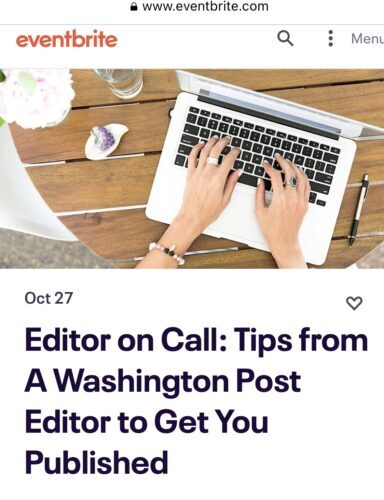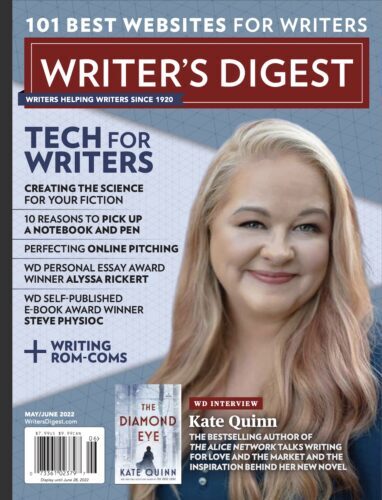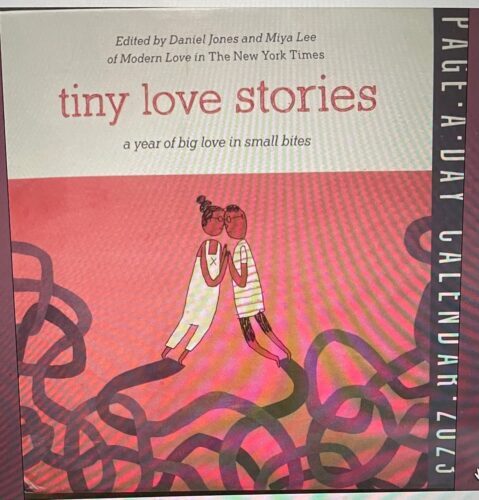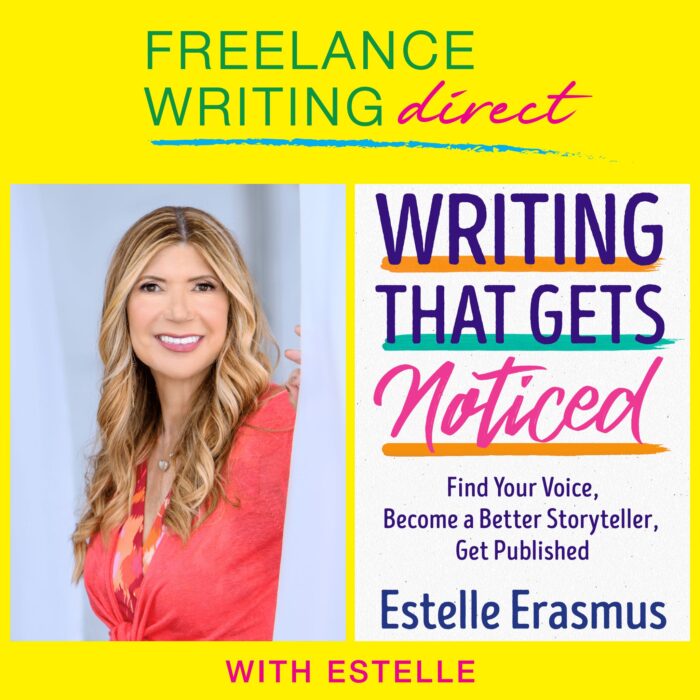I recently was in conversation with Allison Klein, Inspired Life editor at The Washington Post for a free NYU event. Several of my students have published heartwarming stories with Allison, so I thought she’d be ideal for my first of the Editor-on-Call series (stay tuned here for another announcement soon).

Back to the event. It was amazing, and Allison shared so much great info. Here is a recap, plus info from my Writer’s Digest “All About the Pitch” interview with her from the May/June issue of Writer’s Digest and a few bonus Estelle’s Edges (aka pro tips) sprinkled in.


Estelle’s Edge: When interviewing someone, put together your list of questions ahead of time. The conversation might diverge a little (as mine with Allison did), but you have a base to come back to. I also print them out in large 16 point type, so I can easily see them, and not look like I’m straining. When it comes to questions, go for those that are open-ended (not a yes or no question). The only yes/no questions should be for specific factual information that you need (aka, how many stories do you run a day)?
For my first question, I asked Allison to talk about her role as Editor for the Inspired Life Section of The Washington Post? I also asked how many stories does she run a day? A week?
What is the Inspired Life Blog for The Washington Post All About?
Inspired Life focuses on stories close to the news that offer a humane or inspired moment. “I care about people who might be overlooked, forgotten, or treated unfairly,” says Allison. “For example, if there is a mass shooting or a horrible event that makes you feel terrible about our culture, we try to show people that all isn’t lost. We have heroes, too.”
Estelle’s Edge: If you can tell a timely story about average people who do something unusual or extraordinary, or you are that person yourself, and your story has a strong emotional element, you might capture Allison’s attention.
What is Her Role?
Allison told me she selects stories, assigns, edits and works with photography to produce the stories and work with other sections to promote it to it gets featured on the home page and the home channel. She also promotes stories through social media. Allison usually runs one story a day M-F, and 3-5 stories a week (with 3 stories on a slow week). She usually has more reported pieces than personal pieces, or personal pieces with reported elements, but she likes both and she especially likes essays that are topical and leave the reader with an interesting take away or bit of wisdom they can incorporate into their lives. The stories have to be universal or deeply personal—something you learned. If it’s a story from thirty years ago, there has to be something full circle that brings it back to modern times.
Estelle’s Edge: Try to find a story from your past and see if you can also find something in the news that connects to it, or a trend, or something that you are doing (maybe a ritual 30 years later that has meaning and will make sense to others).
What Topics Do You Stay Away From?
Allison avoids taking stories on corporate life or fundraising because there’s so much out there that isn’t newsworthy. They also stay away from politics and anything corny or saccharine, and remembrances, or score-settling essays or accusing someone of a crime, because that isn’t news. There is also a very high bar for pet stories (so forget those lovely viral videos of dogs saying “I love you).” But grassroots stories that haven’t yet gone corporate have a shot.
Estelle’s Edge: Anything too literary won’t work, neither will poetry. The Washington Post is a news organization after all.
What Stories Have Been Really Successful?
Allison told me that several stories have done very well, and that quite often pieces on the site go viral. The blog is online but individual stories get picked up for other sections of The Washington Post (and sometimes for print).
For example, last year, during the big ice storm in Texas, a grocery delivery person got stuck in a driveway and hit a small tree. She apologized, the family invited her in, and she ended up staying with them for five days waiting for them to dig out the car. They cooked together and became friends.
Another story that did very well is when three women discovered they were dating the same man, dumped him, and went on a months-long road trip together.
In one of her favorite stories, two women who worked for the same company met in a bathroom and discovered both of their husbands needed kidneys. Each ended up a match for the other person’s husband. The surgeries had just happened when they ran the story, so it had a newsy feel to it.
One story ran about how during Halloween a woman went to cemeteries and found recipes on headstones and then made the recipes on TikTok. It was a fascinating story posing the questions: Why would people do this? And why would people put recipes on headstones?
She mentioned at the NYU event that one man wrote a story about having an emotional support alligator who helped him after a cancer diagnosis. A little disclaimer: Don’t do this at home.
Estelle’s Edge: Another popular story was about a 10-year long-standing coffee date with a 90-year-old friend, and the other friend is 6 decades younger. That is a great example of a story that isn’t connected to the news, but has an interesting dramatic angle, as the friendship intensifies throughout the years, and a modern connection.
I asked Allison: Should Someone Pitch or Send the Whole Piece?
Allison only accepts complete pieces, not pitches. That is because it is the only way she can see how a story is executed (which, as an editor myself, I completely understand). And she prefers to receive one piece at a time. Before pitching, read the blog. And headlines are very important. Allison suggests writers think about what the headline should be and why someone should click on it?
Estelle’s Edge: Go on the site and do a search for your topic to see how it’s been covered before.
Submission Tips?
I asked Allison for submission tips and any pet peeves, and I also wondered if she reached out to potential writers on social media when she saw posts — an experience many of my students have had with different editors?
Allison said she is looking for diversity in voices for both writers and sources. She told me she also constantly scours TikTok and Instagram. Sometimes, she will ask the person if she can interview them, but usually won’t have them write the story themselves.
Estelle’s Edge: I tell students if they are getting a great response to a post, to take it off social media and make it into a story and pitch it. And when you are writing something, ask yourself, So What? Why would someone be interested? What makes it universal?
I always get down to what I call the nitty gritty. Rights, word count and pay
Allison says the sweet spot is 1,000-1,200 words for reported pieces and essays. Some stories are as short as 600-800 words. They take first rights (meaning rights revert back to you after a period of time so you can sell the piece or repurpose it in some way), and they pay $350.
Estelle’s Edge: Any time you get rights back, that is a win. I think it’s a great contract.
Bottom line: If it’s an uplifting story and appealing to a lot of people, submit it.
Making Contact
Follow her on Twitter at @alliklein. Email is first name.last name@washpost (dot).(com. You can follow up after a week.
And you can follow me on Twitter at @EstelleSErasmus and email me at estellesedge2022@gmail (dot) (com). Also, follow me on TikTok and Instagram and check out the Freelance Writing Direct podcast ( on iTunes and Spotify) for craft tips, actionable tips on writing and freelancing, writing personal essays, interviews with authors and more.
Special Offer
Email me at freelancewritingdirect@gmail.com by December 10th with a tip you learned from one of our podcast episodes, and I will add you into a drawing to receive a Tiny Love Stories Page-A-Day-Calendar. Bonus points if you leave a review on iTunes. My Tiny Love Story is on June 24th in the calendar. I’ll even sign it if you want.



…Estelle, thank you. You’ve inspired and educated this hopeful new first time writer with the information and guidance needed to regroup and fall-in. You introduced me to the micro memoir style; it is thrilling and challenging but the real joy in reading your blog is to come across the shiny, crisp short “Estelle Edge” tips you’ve nestled in between. They’re like finding golden nugget bread crumbs you’ve dropped along on my hopeful pathway.
Thank you. I’m so happy to hear that my “Estelle’s Edge” tips are helping you!